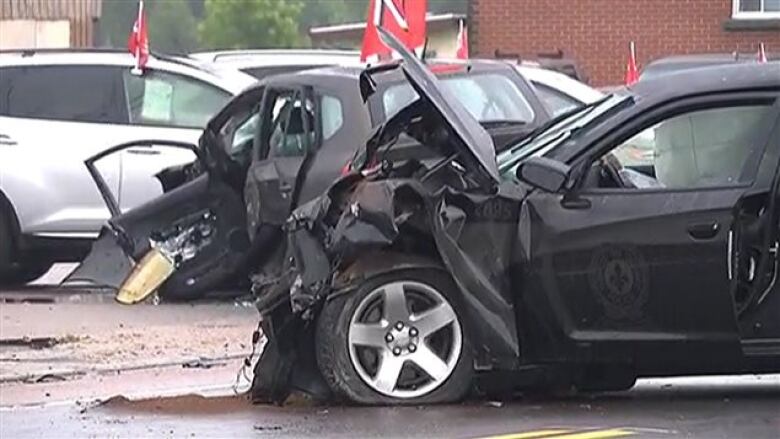Quebec provincial police to teach recruits about risks of driving unmarked cars
SQ won't set maximum speed for unmarked cars, but will track accidents and update training

Quebec's provincial police force is making a number of changes following two deadly accidents involving unmarked police cars.
-
Quebec man who lost father in crash wants restrictions on unmarked cruisers
-
SQ officer charged with dangerous driving in death of 5-year-old
The Sret du Qubec (SQ) has updated the training for recruits to include a section on the risks of driving semi-identified or unidentified cars.
The SQ has210semi-identified or unmarked police vehicles and858 police cruisers. The force will start tracking accidents involving all of its vehicles to see if any patterns emerge, depending on the type of vehicle or the officer driving it.

An unmarked police cruiser was involved in an accident in Dolbeau-Mistassini, north of Lac St-Jean, on July 18, 2015, killing three. (Radio-Canada)
On Feb. 13, 2014, five-year-old Nicholas Thorne-Belance died when an unmarked police car slammed into the side of his father's car as it was moving through an intersection in Longueuil.
A police officer, Patrick Ouellet, is facing criminal charges for dangerous driving causing death in the Longueuil case.
Witnesses to both the accidents said the unmarked cars were speeding.
Strictest rules in North America
SQ spokesman Lt. Jason Allard said a committee struck after the fatal Dolbeau-Mistassini accident found the provincial force already has the strictest rules in North America governing the use of unmarked cars.
"However, that doesn't change [the fact that] the rules can be better, and public safety is number one," said Allard.
The committee looked at accidents involving unmarked cars across North America and its own statistics.
It found fewer accidents for unmarked cars: 1 per 150,000 kilometres compared with 1 per 100,000 for marked cruisers.
Since July 2015, unmarked cars can only be used in three sets of circumstances:
-
If the officer is closest to a scene where lives are in danger.
-
In order to stop traffic violations, such as speeding or running red lights.
-
With permission from a superior officer.
No set speed limit
Allard said the committee looked at the question of speed limits and decided against imposing a maximum speed limit.
He said there were suggestions of installing a device that would tell the driver when he or she had gone over a certain speed.
"Depending on the situation, depending where you are, no electronic device can supercede the good judgment of an officer," said Allard.
All five of the committee's recommendations have now been in place for the past few weeks.
Along with new training for recruits, tracking accidents and other changes brought in last year, they include online training for officers already on duty.












_(720p).jpg)


 OFFICIAL HD MUSIC VIDEO.jpg)
.jpg)



























































































